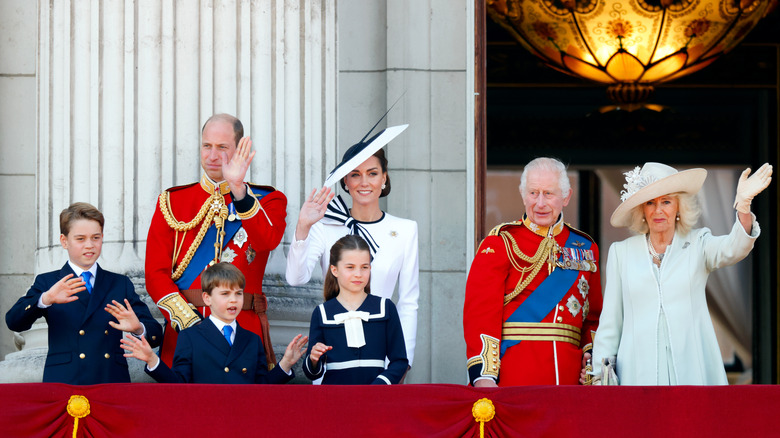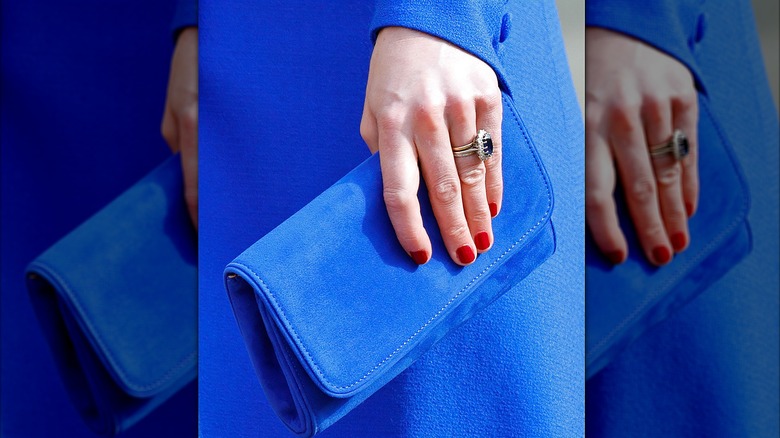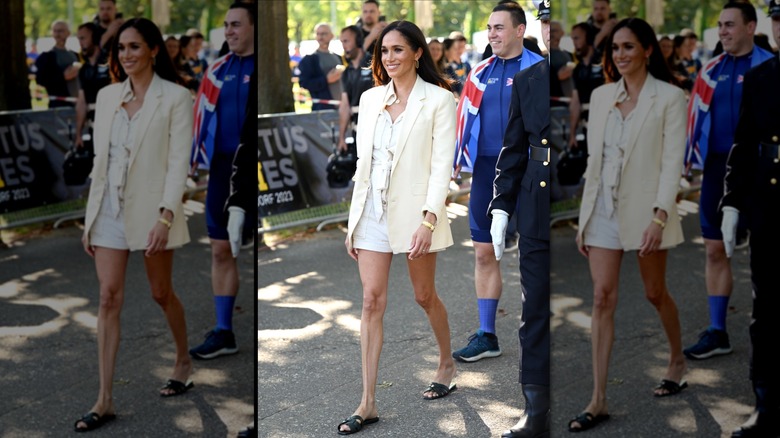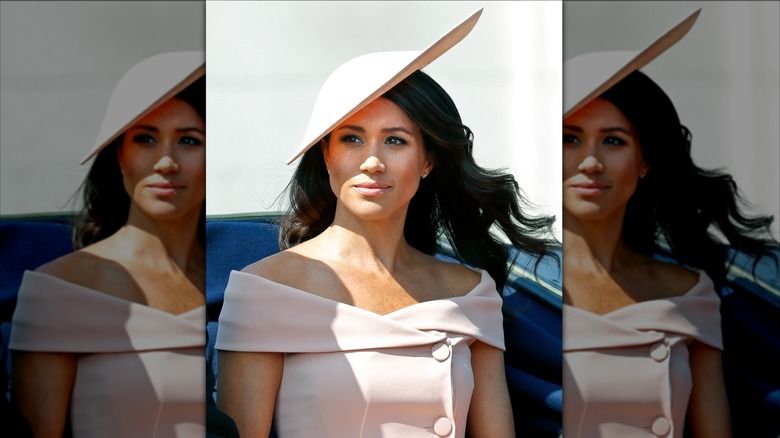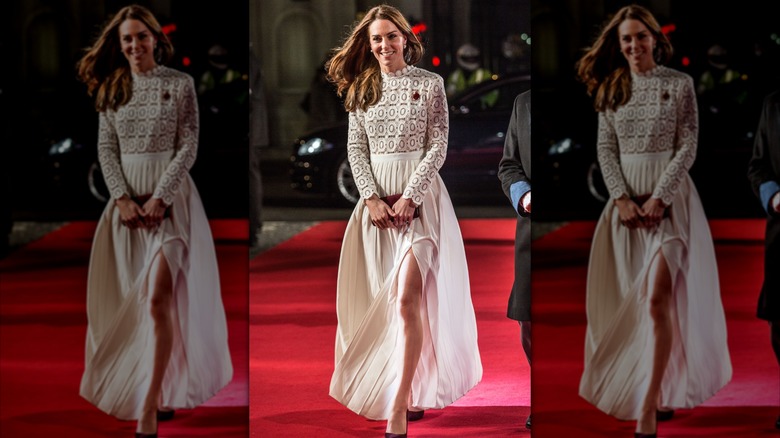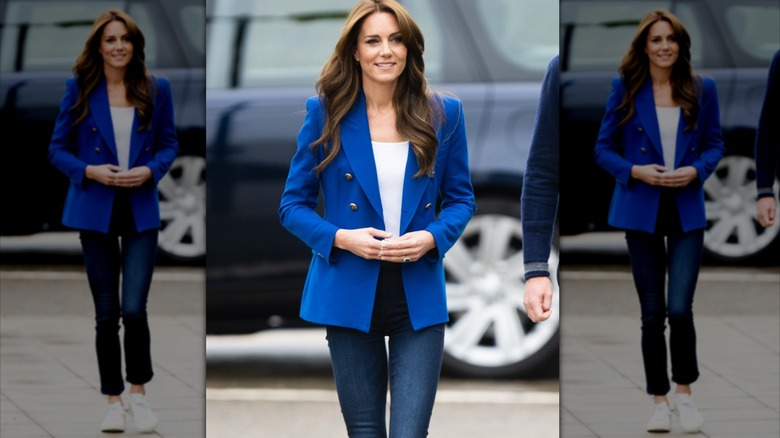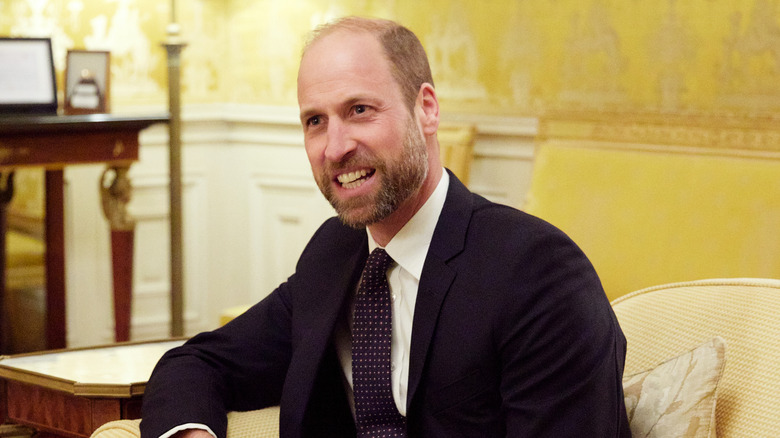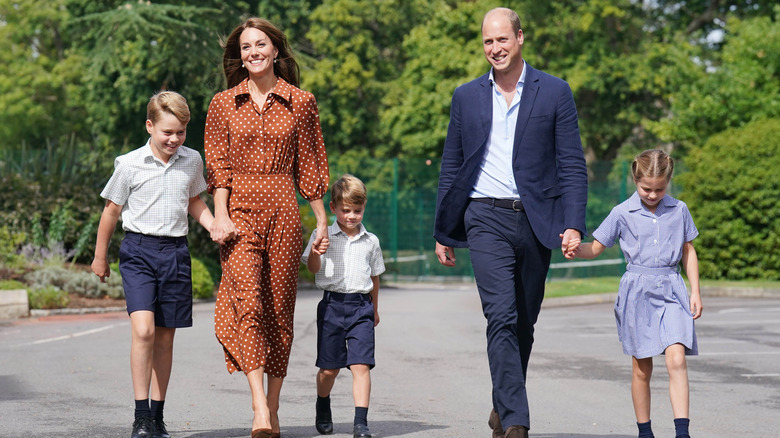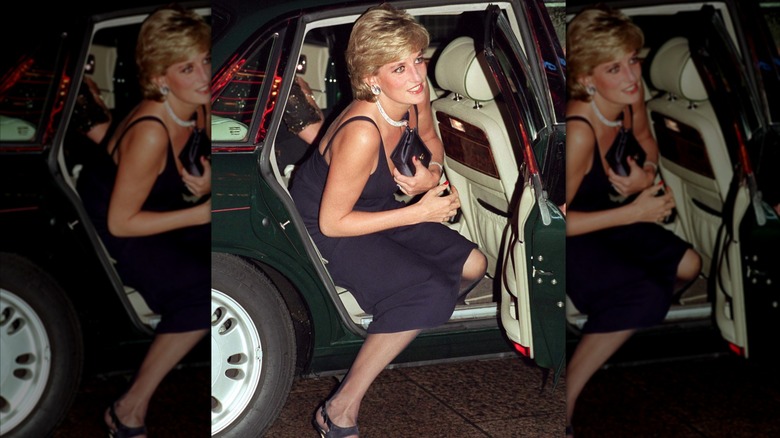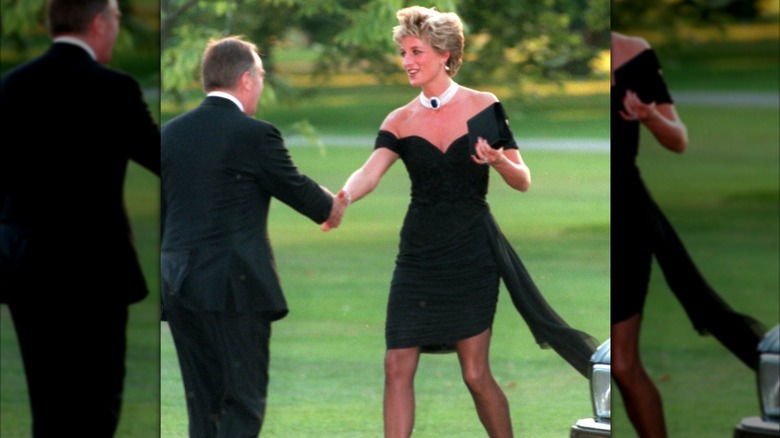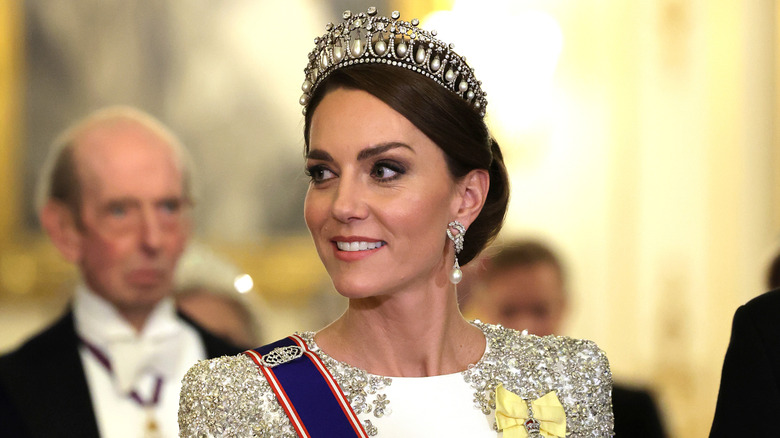10 Styles You Thought Were Forbidden For Royals But That Actually Aren't
Royals are not like the rest of us. For example, you probably won't see Catherine, Princess of Wales running around in sweats and a messy bun, with a Stanley cup in her hand and a Lululemon crossbody slung over her chest. That's because there are strict rules royals from around the world have to follow that don't apply to the commoner. There are certain trends and styles that, while not expressly forbidden, are frowned upon. Royals are held to higher standards and a level of decorum that dictate every aspect of their lives. And while we don't know if they are allowed to lounge around in their PJs behind closed castle doors, we do know that whether at a royal function or a casual sporting event, there is a preferred dress code to which they tend to strictly adhere in public. "The outfit has to be modest, elegant and appropriate for the occasion, and it should never distract from the royal's role or risk causing a scandal or public debate," Windsor and royal expert Richard Fitzwilliams told Reader's Digest.
However, as fashion has evolved over the years, so to has the royal approach, with many of the younger, more modern members of the monarchy occasionally pushing the envelope of what has always been considered acceptable. Former royal butler Grant Harrold, told Daily Mail, "If you look at Princess Diana or Catherine, they've worn outfits that some might say bend those rules a bit, but they've always stayed true to the protocols." From Duchess of Sussex Meghan Markle's bare legs, to Catherine, Princess of Wales' red nails, here are a 11 styles that you probably thought were forbidden for royals, but actually aren't.
Dark nails are a no-no
The royal women always look polished, from the tops of their heads to the tips of their toes. But when it comes to manicures and pedicures, here's a tip about the royal tips: Although bright or dark nails aren't the norm, they aren't forbidden. This was illustrated when Catherine, Princess of Wales was photographed rocking red nails with a bright blue ensemble while attending an Easter Sunday service. Although it was out of the norm for the princess, who usually favors a light or neutral shade, a colorful manicure is not forbidden for the royal women, contrary to popular belief. "There's no actual protocol about dark nail polish," royal correspondent Omid Scobie told Harper's Bazaar. "It's simply about being appropriate."
So, why has it always been assumed that there was a ban on bold nails? Perhaps because it was widely known that, although Queen Elizabeth II loved brightly colored clothing, she favored light nails. Essie Ballet Slippers, while not one of the beauty brands that received Queen Elizabeth's official approval, was her go-to shade. As the head of the monarchy, anything the queen did set the tone for the rest of the royals. That means you are also unlikely to see glitter, chrome, nail art, or long, almond shaped talons on royal fingertips. "The Royal Family tends to favor sheer, neutral shades on shorter, squoval-shaped nails," Sarah Gibson Tuttle, founder and CEO of Olive & June, told Harper's Bazaar. "It's a super-classic, clean look that looks timeless and royal appropriate."
Bare legs are banned
Call them pantyhose, stockings, or tights, but don't call out Meghan Markle for not wearing them. Although the Duchess of Sussex frequently raised eyebrows for daring to show her gorgeous gams, there is nothing in the royal rulebook that makes baring your legs forbidden. It's really more out of respect for the senior royals, specifically, the late Queen Elizabeth II, who is said to have preferred that all the royal women wear nude hosiery or stockings at formal events. "Although pantyhose are not required for every event, they are generally a rule for more formal or conservative royal events," Christine Ross of Meghan's Mirror told E! News. She added that there might be another, more basic reason for the preference: "The perception is that pantyhose are more modest and feminine, but given how chilly London can be, it may be a practical choice more than anything!"
Meanwhile, Catherine, Princess of Wales is rarely if ever seen sporting bare legs, though she may occasionally forgo her normal nude in favor of a sheer black or even opaque tight. This is hardly surprising given that she is considered to be less of a wave-maker among the royal clan than her American counterpart. "Meghan did not wear a lot of nude stockings, but then when she and the Queen appeared together, she did," Elizabeth Holmes, veteran fashion journalist and author of "HRH: So Many Thoughts on Royal Style," told Business Insider. "Kate leans into this stuff much more than Meghan did."
No cleavage or cold shoulders for the royals
Few royals have brought more attention to the royal dress code than Meghan Markle. From her frequent shunning of stockings, to her signature messy bun, the Duchess of Sussex has frequently drawn fire for all the ways she is breaking the royal rules. Even the demure pale pink Carolina Herrera suit she wore to Trooping the Colour in 2018 caused a royal stir for its shoulder-baring style. "It was deemed by some people to be a bit revealing, but personally I couldn't see any harm in it," Joe Little, Majesty managing editor, told People. "She looked great."
Why all the fuss, you ask? Well, it is assumed that royals are forbidden from showing shoulders or cleavage, especially at official events. But the truth about the royal family dress code is that this is not the case. But just because it isn't forbidden doesn't always mean it's appropriate for every occasion, particularly those attended by the late queen, who had definite preferences when it came to the royal attire. "It's less about personal expression and more about how their appearance supports their duties, from projecting professionalism to creating a sense of approachability and respect," etiquette expert Myka Meier told Daily Mail. It should also be noted that the duchess isn't the only one who has shown some skin at formal events. The late Princess Diana famously bared her shoulders and cleavage numerous times, including in the famously dubbed "revenge dress" that showed King Charles III, and everyone else, exactly what he was missing.
Mini skirts are a royal no
Prior to becoming Catherine, Princess of Wales, Kate Middleton was a typical college girl who loved a short skirt moment. Once she landed her prince, however, Kate underwent a stunning transformation that included a wardrobe fit for a queen. But did she really have to get rid of her minis in order to maximize her role as a royal? The answer is no, mini skirts are not forbidden. However, like bare shoulders and cleavage, showing too much leg could be seen as inappropriate and not a look befitting a distinguished member of the royal family. Once again, it comes down to propriety and protocol. "It's all about being modest, elegant and not risking a scandal or causing a media fuss," etiquette expert Laura Windsor explained to Reader's Digest. "Royal ladies are expected to wear knee length or longer."
Kate, who is frequently praised for dressing on point, has been known to occasionally skirt the issue and flash more than a little leg in a long skirt with a thigh-high slit up the side. Although the side split may earn her some side-eye from the more conservative royals, she is not breaking any official rules. She is also not the first royal to show off her gorgeous gams via a peek-a-boo design. The late Princess Diana, along with Princess Beatrice and of course Duchess of Sussex, Meghan Markle, have all put their best foot, er leg, forward in public.
No jeans for royal genes
If you're a denim and T-shirt kind of person, then being a royal might not be for you. That's because, although they are not forbidden, jeans are reserved for extremely casual occasions such as sporting events. Even then, they are not likely to have holes in them (even intentionally) or to be paired with a concert tee and Birkenstocks. Instead, they are usually worn with a blazer or jacket and flats, or a nice pair of tennis shoes depending on what the situation dictates. Catherine, Princess of Wales is often seen in jeans when she's hanging out with her children and pets, which according to etiquette expert Laura Windsor, is a sign of how far the royal family has come in terms of relaxing the rules a bit. "Jeans wouldn't have happened in Queen Elizabeth's lifetime as a young woman," she told Reader's Digest. "She was always supposed to look her part, but things are way more casual now."
Also, it is important to remember that the royals are a sporty bunch who enjoy hunting, sailing, horseback riding, and other activities where more formal attire would be a hindrance. Diana Mather, a senior tutor for The English Manner etiquette consultancy, told the BBC that while jeans may be considered acceptable as part of the modern casual dress code for royals, it is better to be safe than sorry. "Many places will not allow jeans as they are still seen as very casual wear, so it is better to play safe for both sexes," she said.
No facial hair for heirs and spares
Prince Harry, Duke of Sussex revealed in his memoir "Spare" that, while facial hair is not forbidden, it has been a prickly subject for the royal men. Specifically, it caused a bit of a rift between Harry, who has rocked a beard for much of his adult life, and his older brother William, Prince of Wales, who reportedly has been encouraged to remain clean-shaven. However, William took a page from his baby brother's book when he appeared with a beard in a video he recorded with his wife, Princess Catherine, in support of the Team Great Britain prior to the closing of the 2024 Olympic Games in Paris. Maybe now that he's even closer to becoming the king of England, he's making his own rules. "He's saying, I am stepping into to my full role as a man, and maybe I don't want you thinking so much of my little boy face," Dr. Allan Peterkin, a professor of psychiatry at the University of Toronto and the author of "One Thousand Beards: A Cultural History of Facial Hair," told The New York Times. "What you see is a fully grown, mature man ready to wear the crown."
Whatever the reason for Prince William's whiskers, there is no rule that expressly forbids them. Again, it is a matter of propriety. "A clean shave is the look to go for if you're part of the British royal family," etiquette expert Laura Windsor told Reader's Digest. And, apparently, Princess Charlotte agrees. Prince William revealed per the Independent that his daughter was not a fan of his facial hair, and said it left her in "in floods of tears."
No long pants on little legs
Royal protocol starts at birth, with even the tiniest members of the monarchy governed by a set of royal expectations when it comes to appearing in public. That's why you will never see a little boy in long pants. Although they are not strictly forbidden, long pants are not seen on male members of the royal family until they are around 8 years old. This is one tradition that the royals tend to follow, not so much because it's seen by some as a hard "rule" but more because of the reasoning behind it. "It's a very English thing to dress a young boy in shorts," explains the etiquette expert William Hanson in Harper's Bazaar. "Trousers are for older boys and men, whereas shorts on young boys is one of those silent class markers that we have in England. Although times are (slowly) changing, a pair of trousers on a young boy is considered quite middle class — quite suburban."
This may seem like an odd tradition to cling to, especially when it involves layering coats over little legs during the chilly English winter, but it doesn't seem to be going away any time soon. "The modern habit of upper class families choosing to dress their boys in shorts will deliberately hark back to a bygone age," said Hanson. "The British upper set are always keen to hold on to tradition, and this one also silently marks them out from 'the rest.'"
Say no-no to hobo bags and other oversized purses
The royals are not forbidden from carrying large purses or crossbody bags, but you will rarely see them with one slung across their shoulders, and the reason has less to do with style than you might think. Royal women tend to favor small, hand-held bags that come through in a clutch (pun intended) to stave off a number of potentially awkward situations. For example, the late Princess Diana often used hers as a way to cover her décolletage as she exited a vehicle to prevent the press from getting a shot of her cleavage. "We used to laugh when we designed what she called her 'cleavage bags,' little satin clutches which she would cover her cleavage with when she stepped out of cars," designer Anya Hindmarch told The Telegraph (via Vogue Australia).
Besides blocking paparazzi shots, the royal women have become adept at using these little bags for reasons far beyond holding a lipstick. For instance, Catherine, Princess of Wales often uses hers to avoid unwanted contact. "Princess Kate sometimes uses her clutch so she doesn't have to shake hands with everyone," etiquette expert Laura Windsor told Reader's Digest. "It's a barrier, a body language message that says, 'I don't want to — or can't — shake hands with you.'" For the late Queen Elizabeth II, who often carried a small handbag with a short handle, the purse conveyed a bigger message. Royal expert Richard Fitzwilliams explained to Reader's Digest, "If she shifted it from one hand to the other or placed it on the table, it meant that she was ready to go."
Black clothing is forbidden except at funerals
There are no colors that the royals are forbidden from wearing, but they do like to stand out from the crowd. Hence, they often sport bold, bright colors like those favored by the late Queen Elizabeth II. Black, while elegant and modern, is typically reserved for funerals. However, that doesn't mean that the royals are forbidden from wearing it anywhere else. The late Princess Diana often turned to black for evening and formal occasions, and who can forget her iconic "revenge dress" moment? "Princess Diana had her own dress code," royal expert Richard Fitzwilliams told Reader's Digest. "It was an iconic moment when she showed up in a little black dress the same night her then-husband Prince Charles confessed his infidelity on national television. It was seen as a rebellious act."
Another royal rebel, Meghan Markle, the Duchess of Sussex, once sported an all-black ensemble when she accompanied her husband Prince Harry, Duke of Sussex on an official tour of Australia back in 2018. Later that year, she was also spotted wearing a black Givenchy dress at the Fashion Awards while still a working royal. Not only did the bodycon gown fly in the face of etiquette with its color, the one shoulder design was considered another breech of protocol. Even the ever-appropriate Princess of Wales has fallen prey to the allure of a black evening gown, stepping out in a sleeveless black velvet gown for an awards ceremony in 2011 and a black lace gown for a movie premiere in 2012.
No tiaras before marriage
Heavy is the head that wears the crown, or so the saying goes. Perhaps that's why it is assumed that there is a rule forbidding any young or single women from wearing one. The truth is, that, while not forbidden, it is a little complicated. Typically, a royal does not receive her first tiara until her wedding day. But, like many royal rites of passage, there are exceptions. Working female members of the royal family may be able to secure a glittering headpiece prior to securing a husband. That was the case for both Princess Anne and Princess Margaret, both of whom wore tiaras to parties and royal events while they were still single women. So why were tiaras thought to be forbidden before marriage? "For married ladies it was a sign of status and would show you were taken and not looking for a husband," etiquette expert Grant Harrold, known as The Royal Butler, explained to the BBC. "For the gentleman it was a clear sign not to make advances toward the lady in question."
As for the Prince and Princess of Wales' only daughter, the truth about Princess Charlotte is that with her position in the royal family, there is a good chance that she could become a working member before she becomes a bride and could potentially wear a tiara of her own. The little princess got a some practice in the protocol at the 2023 coronation of her grandfather, King Charles III. Princess Catherine's mini-me shone as brightly as her mother in a silver, sparkly headpiece by Jess Collet x Alexander McQueen.
